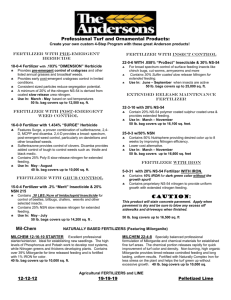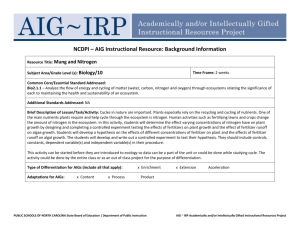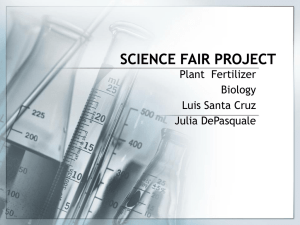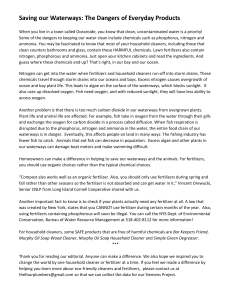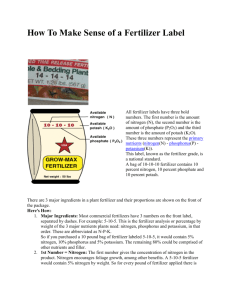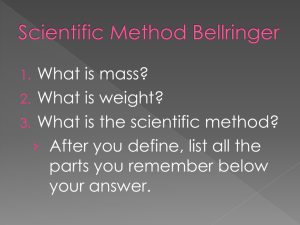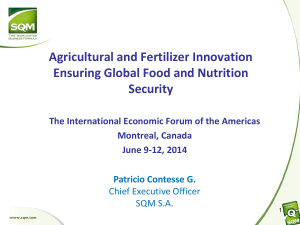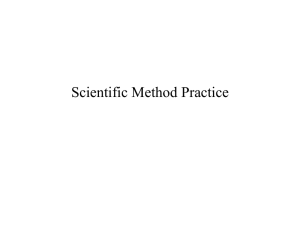A Plant`s Grocery Store - Brookville Local Schools
advertisement
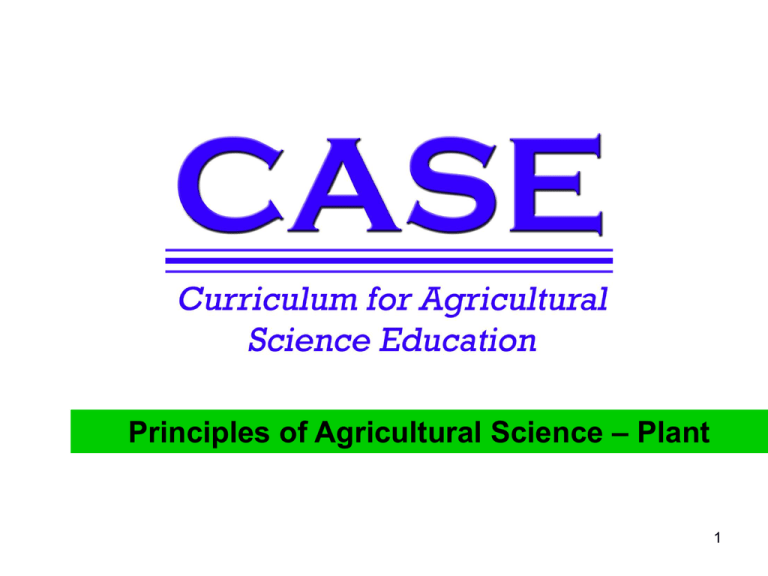
Principles of Agricultural Science – Plant 1 Principles of Agricultural Science – Plant A Plant’s Grocery Store Unit 6 – The Growing Environment Lesson 6.1 Plant Food 2 Sources of Plant Nutrients • Organic Substances • Legumes • Chemical Fertilizers 3 Organic Fertilizers • Manure, sludge, and compost are three types of organic amendments. • Animal manure contains N, P, & K. • Sludge is processed human waste. • Composting can raise organic matter in the soil and reduce pathogens. 4 Legumes • Legumes fix nitrogen. • Legumes, such as peanuts, soybeans, and vetch “improve” the soil they are grown in, rather than depleting macronutrients like most crops. • Often legumes are “double-cropped” (planted) after a nitrogen depleting crop has been harvested. 5 Chemical Fertilizers Manufactured fertilizers use inorganic compounds to concentrate desired nutrients Benefits Disadvantages • Easy to apply • Expensive • Concentrated • Petroleum based • Readily available • Formulated to plant needs 6 Forms of Chemical Fertilizers Commercial chemical fertilizer comes in different forms: • Dry (granular or pelleted) • Liquid • Water soluble powder 7 What the Numbers Mean The first three numbers of a fertilizer analysis is always the N-P-K percentage. Example: A bag of 10-20-10 means the bag contains: • 10% nitrogen • 20% phosphorus • 10% Potassium 8 Let’s do some math… How much nitrogen is in a 100 lb. bag of 1516-17 fertilizer? Correct: 15 lbs. 15% x 100 = .15 x 100 = 15 lbs. 9 A little harder one… How much phosphorus is in a 50 lb. bag of 15-16-17 fertilizer? Answer: 8 lbs. .16 x 50 = 8 or set up the formula: 10 Try one more… How much potassium is in a 5 lb. bag of 20-10-20 fertilizer? Cross multiply to solve for X lbs. of potassium: 20 x 5 = 100x this equals 100 = 100x 100 = 100x 100 100 1 = x Therefore, 1 lb. of K 11 Calculating Fertilizer Application Rates You want to know how many pounds of fertilizer you need to apply in order to get enough nutrients to a plant. 12 Let’s try a rate calculation… You want to add fertilizer to a family member’s yard. • They have 1000 square feet of lawn • Recommended amount of nitrogen application is 1 lb /1000 sq. ft. • The fertilizer you have is 16-16-16 How much nitrogen fertilizer should you apply? 13 Problem Solved Set up the formula: 16x = 100 x = 6.25 lbs. of fertilizer for every 1000 sq. ft. 14 Calculations Depends on Form • Dry fertilizers are expressed in weight measurements • Liquid or water soluble fertilizers are expressed in parts per million (ppm) 15 Fertilizer Cost Cost can be confusing… Why does a 100 lb bag of 20-20-20 cost twice as much as a 100 lb bag of 10-10-10? Nutrient content is based on percentage, 20-20-20 has twice as much nutrient value as 10-10-10. 16 Activity 6.1.3 Fertilizer Figures Activity 6.1.3 Fertilizer Figures will allow you to practice these calculations. You will determine: • • • • Pounds of nutrient per pound of fertilizer Fertilizer application rates Liquid fertilizer application rates in ppm Fertilizer costs 17 References Parker, R. (2010). Plant and soil science: Fundamentals and applications. Clifton Park, NY: Delmar. Plaster, Edward J.,(1992). Soil science and management (2nd Ed.). Albany, NY: Delmar. 18

